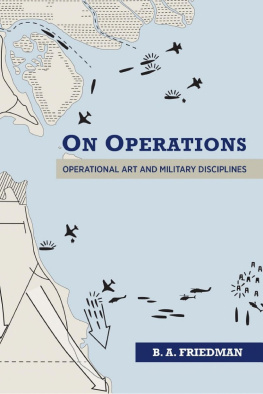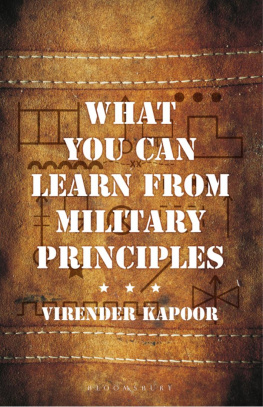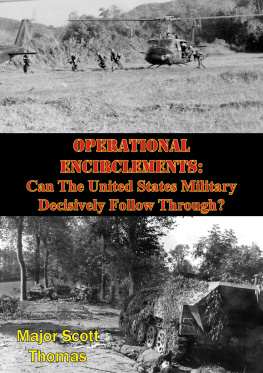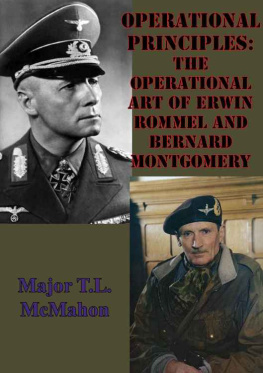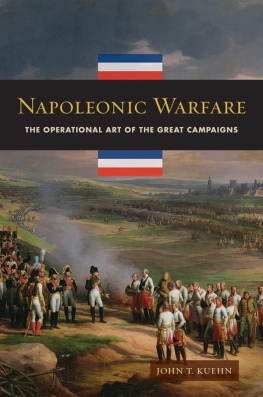ON OPERATIONS
ON OPERATIONS
OPERATIONAL ART AND MILITARY DISCIPLINES
B. A. FRIEDMAN
NAVAL INSTITUTE PRESS
Annapolis, Maryland
Naval Institute Press
291 Wood Road
Annapolis, MD 21402
2021 by Brett Friedman
All rights reserved. No part of this book may be reproduced or utilized in any form or by any means, electronic or mechanical, including photocopying and recording, or by any information storage and retrieval system, without permission in writing from the publisher.
Library of Congress Cataloging-in-Publication Data
Names: Friedman, B. A. (Brett A.), author.
Title: On operations : operational art and military disciplines / B. A. Friedman.
Description: Annapolis, Maryland : Naval Institute Press, [2021] | Includes bibliographical references and index.
Identifiers: LCCN 2021024742 (print) | LCCN 2021024743 (ebook) | ISBN 9781682477069 (hardback) | ISBN 9781682477076 (ebook) | ISBN 9781682477076 (pdf)
Subjects: LCSH: Operational art (Military science) | Operational art (Military science)Case studies.
Classification: LCC U162 .F8 2021 (print) | LCC U162 (ebook) | DDC 355.409dc23
LC record available at https://lccn.loc.gov/2021024742
LC ebook record available at https://lccn.loc.gov/2021024743
Print editions meet the requirements of ANSI/NISO z39.48-1992
(Permanence of Paper). Printed in the United States of America.
29 28 27 26 25 24 23 22 21 9 8 7 6 5 4 3 2 1
First printing
This one goes out to the adjutants. I see you.
CONTENTS
1. Operations and the Napoleonic Revolution
2. German Operational Thought
3. Soviet Operational Thought
4. American Operational Thought
5. The Operational Level and the Civil-Military Relationship
6. A Theory of Operational Art
7. Administration
8. Information
9. Operations
10. Fire Support
11. Logistics
12. Command and Control
13. Campaigns, Battles, and Decision
14. Campaign Taxonomy I
15. Campaign Taxonomy II
16. Operational Art Actualized through a Modern Staff System
17. A Note on Force Protection
PREFACE
This book, like my previous book, is Clausewitzian. By that, I mean that it falls within a framework of what war, warfare, strategy, and tactics are as a phenomenon as described by Carl von Clausewitz (17801831). Olivia Garard, rhyming with Alfred North Whitehead, has said that all strategic theory is a series of footnotes to Clausewitz. I would instead say that all good strategic theory is a series of footnotes to Clausewitz. Good footnotes to Clausewitz is all I hope these books to be. If you are looking for something non-Clausewitzian, this is not it. There are certainly publications that can provide that, but I do not recommend any of them.
This volume would still be a formless jumble of notes were it not for my wife, Ashton, whose comment triggered the chapter that really ties the whole book together.
During one conversation, Col. Doug King, USMC (Ret.), said one sentence that clarified all of my thinking about the command-and-control chapter, Control is what the staff does. I have a lot to thank Doug King for, but this is the one most relevant for this book.
Capt. Wayne Hughes, USN (Ret.), greatly influenced my previous book, On Tactics: A Theory of Victory in Battle (2017), and generously shared his experience and knowledge with me as I worked through the manuscript for that volume. He was also instrumental in its acceptance for publication. In December 2019 he passed away. His influence will live on in the naval and strategic theory communities, and I remain grateful for his guidance. Fair winds and following seas.
Conversations with colleagues have sharpened the ideas contained herein on a number of occasions, especially those with Lt. Col. Gregory Wardman, USMC (Ret.), and Capt. Olivia Garard, USMC. Olivia especially helped me think through the campaign taxonomy, while Greg considerably shaped my thoughts on the information discipline. I owe them both a debt of gratitude.
David Alman pointed me in the direction of motivator-hygiene theory, which strengthened the chapter on administration.
There are two weaknesses in this book, I believe. One is an unfortunate focus on so-called Western history and thought. This is a function both of the paucity of sources readily available to an independent writer such as myself and the fact that the operational level of war is a fundamentally Western concept. So, while the operational art of the Peoples Liberation Army (PLA) of modern China is an interesting subject, its discussion is excluded from the following chapters. Briefly, however, current PLA thought has what might be described as four levels: military thought (junshi sixiang), military strategy (zhanle), campaigns (zhanyi), and tactics (zhanshu). Nonetheless, these concepts do not exactly map to Western conceptions of the operational level or operational art, which is the focus of this book. Western writers sometimes conflate campaigns, joint warfare, and the operational level when describing PLA ideas, but this is a misunderstanding of U.S. doctrine and an assumption about Chinese thought. For example, the Western operational level of war is sometimes depicted as the ways part of an ends-ways-means formulation of strategy. But the ways of this construct is more similar to the Chinese idea of strategic means (zhanle shouduan) than to the operational level. Works in English that connect Western, especially American, doctrinal concepts with PLA doctrinal concepts as direct equivalents should be viewed with extreme skepticism. The Chinese do not have a military doctrine as it is understood in Western militaries, but rather a unique style of military regulation that precludes easy comparison. Those interested in the PLA especially should see M. Taylor Fravel, Active Defense: Chinas Military Strategy since 1949 (2019).
The other weakness herein is an excessive focus on land warfare. This is a function entirely of my own shortcomings and background when it comes to aviation and naval operations. I have made an attempt to include more on those subjects than I did in my previous book, but the attention is still far less than they deserve.
This book, like the last, is not a work of history but one of theory. It uses history extensively, for evidence and explanation to support the theory, but is not intended to be a work of history. It therefore relies mostly on secondary sources. Primary sources in the form of doctrinal manuals and, in one case, a discussion between myself and an author of doctrinal manuals were used, but secondary sources necessarily underpin the development of the theory itself.
If there is any one takeaway from this book and On Tactics, it is that there is no one route to victory in war. There are too many factors that come into play, and theory is at its best when it helps one think about those factors without trying to prescribe solutions. Where I prescribe solutions, they address organizational issues. Hopefully, that is what this book is: a tool for greater clarity. I hesitate to say that I am following in Clausewitzs footsteps except in one respect: that he railed against the purveyors of shallow prescriptions, salesmen promising success if only the proper rules and guides are followed. There are no new rules of war, just as there were no old ones. There are no guarantees and no certainties. There are definitely no simple answers. Anyone saying otherwise is selling snake oil.
Unfortunately, there is far too much of that in the defense world today, growing and accumulating on the U.S. military, especially, like plaque. Some of it comes from academia, some of it from the political punditry rackets on the right and left. Some of it, like the operational level of war, grows from misunderstandings within the U.S. military itself. But all war is subject to probabilities, so there is no way to know whether or not my attack on this particular misunderstanding will be as successful as Clausewitzs was. The only way to know is to launch it.
Next page
